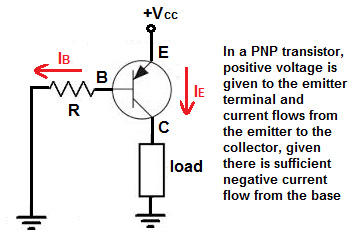
 IT IS situated opposite to the emitter. It forms two PN junctions with Emitter and Collector. So that most of the charge carriers pass to the collector. It is a middle section of a transistor. It is always forward biased with respect to base.
IT IS situated opposite to the emitter. It forms two PN junctions with Emitter and Collector. So that most of the charge carriers pass to the collector. It is a middle section of a transistor. It is always forward biased with respect to base. 
Main function is to supply the majority carriers to the base.To inject a large number of charge carriers.
 polarity of the power supply for each type Collector Base Emitter. Collector ( C ) Principle of operation of the two transistor types PNP and NPN. current regulating devices that control the amount of current flowing through themīJT Basic construction The BJT is a three terminal device that produce two PN junctions. p-type semiconductorsthe material lead to a deficiency of electrons and therefore an excess of positive charge carriers or “holes.”. n-type semiconductorsthe impurities result in an excess of electrons, or negative charges. which basically describes the physical arrangement of the P-type and N-type semiconductor materials. Two basic types of bipolar junction transistor construction,. If the transistor is a PNP, then the arrow points to the base of the transistor, otherwise it points to the output. The symbol of the transistor has an arrow on the emitter.
polarity of the power supply for each type Collector Base Emitter. Collector ( C ) Principle of operation of the two transistor types PNP and NPN. current regulating devices that control the amount of current flowing through themīJT Basic construction The BJT is a three terminal device that produce two PN junctions. p-type semiconductorsthe material lead to a deficiency of electrons and therefore an excess of positive charge carriers or “holes.”. n-type semiconductorsthe impurities result in an excess of electrons, or negative charges. which basically describes the physical arrangement of the P-type and N-type semiconductor materials. Two basic types of bipolar junction transistor construction,. If the transistor is a PNP, then the arrow points to the base of the transistor, otherwise it points to the output. The symbol of the transistor has an arrow on the emitter. 
Each transistor has 3 leads which we call base, collector and emitter, and we use the symbols b, c and e respectively. if the two materials are N and the middle one is P, then we have a N-P-N material or NPN. if the two similar materials are P and the middle one is N, then we have a P-N-P or PNP transistor. A BJT (Bipolar Junction Transistor) transistor has inside two similar semi conductive materials, and between them there is a third semi conductive material of different type. Impurities have been introduced by a process called “doping”. The transistor is an arrangement of semiconductor materials that share common physical boundaries. Brattain, and William Shockley(later jointly awarded a Nobel Prize) It was also independently developed nearly simultaneously by Herbert Mataré and Heinrich Welker, German physicists working at Westinghouse Laboratory in Paris. A semiconductor device that Amplifies, Oscillates, or Switches the flow of current between two terminals Invention of the Transistor American physicists John Bardeen, Walter H.












